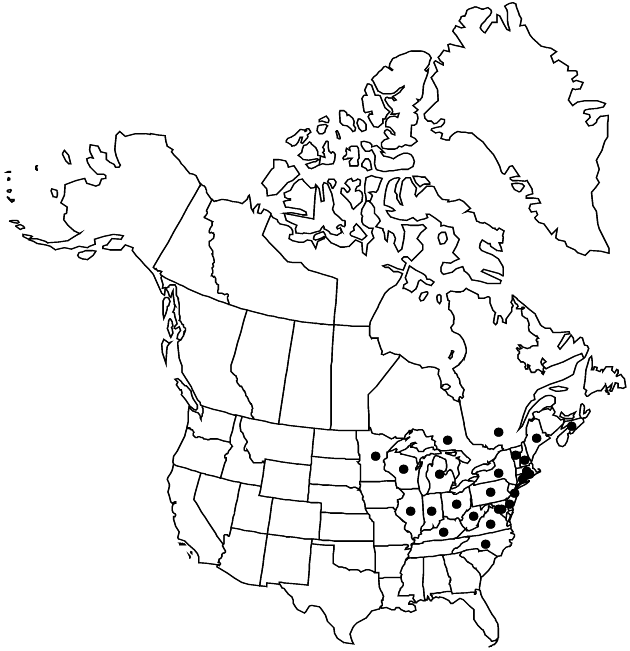Symphyotrichum pilosum var. pringlei
Phytologia 77: 289. 1995.
Common names: Pringle’s aster aster de Pringle
Endemic
Basionym: Aster ericoides var. pringlei A. Gray in A. Gray et al., Syn. Fl. N. Amer. 1(2): 184. 1884
Synonyms: Aster pilosus var. demotus S. F. Blake Aster pringlei (A. Gray) N. L. Britton
Stems glabrous. Leaves glabrous or glabrate. 2n = 48.
Phenology: Flowering Aug–Oct.
Habitat: Calciphile, limestone pavements, calcareous sandy or gravelly shores and beaches of lake and streams, interdunal flats and swales, rarely fens, fields
Elevation: 0–1100+ m
Distribution

N.S., Ont., Que., Conn., Del., D.C., Ill., Ind., Ky., Maine, Md., Mass., Mich., Minn., N.H., N.J., N.Y., N.C., Ohio, Pa., R.I., Vt., Va., W.Va., Wis.
Discussion
Variety pringlei may sometimes be confused with Symphyotrichum priceae, which is distinguished by its larger heads and purple rays. Plants identified as Aster pilosus var. demotus are tall phenotypes induced by ecologic conditions.
Selected References
None.
Lower Taxa
None.
"thin" is not a number.
... more about "Symphyotrichum pilosum var. pringlei"
introrse +
connate +
distinct +
herbaceous +
10mm;60mm +
flowering +
acuminate;acute;attenuate;obtuse;rounded +
involute +
scarious +
hirsute +
papillate +
pyramidal +
continuous +
withering +
spatulate;oblanceolate elliptic or ovate +
clasping +
crenate-serrate +
flowering +
1/2;3/5 +
indurate +
5mm;15mm +
crenate-serrate +
flowering +
lance-oblong;linear-lanceolate +
reduced +
ribbed +
glabrate +
7;25 +
divaricate +
smaller +
ascending +
arched +
10 cm100 mm <br />0.1 m <br /> (?) +
stigmatic +
persistent +
absent +
at maturity , more or less ampliate , tubes usually shorter +
absent +
4-6-nerved +
dimorphic +
equaling +
ampliate +
staminate +
sessile +
straight +
eglandular +
distinct +
proximal +
1;5 +
bisexual +
dispersed +
Calciphile, limestone pavements, calcareous sandy or gravelly shores and beaches of lake and streams, interdunal flats and swales, rarely fens, fields +
singly +
indeterminate +
surrounding +
campanulate;cylindro-campanulate +
5.4mm;7.5mm +
0.8mm;1.3mm +
alternate +
decurrent +
reflexed;spreading;erect +
lanceolate +
? (?) +
hyaline +
flowering +
ciliolate +
entire to serrate +
scarious +
foliaceous +
2-carpellate +
inferior +
attached +
anatropous +
barbellate +
white +
persistent +
shorter +
equal +
tough +
thick +
absent +
connate +
1(-3)-nerved +
persistent +
distinct +
falling +
unequal +
deciduous +
reduced +
5mm;25mm +
Phytologia +
1995 +
absent +
sterile +
reduced +
epaleate +
pitted +
flat;slightly convex +
fibrous +
exalbuminous +
modifed +
pistillate +
4;6 +
fertile +
0.1mm;0.2mm +
Endemic +
alternate +
brittle +
vinelike +
glabrous +
lanceolate +
2-branched +
glabrous +
Symphyotrichum pilosum var. pringlei +
Symphyotrichum pilosum +
variety +
much shorter +
maturity +
rhizomatous +
perennial +
cespitose +
green +